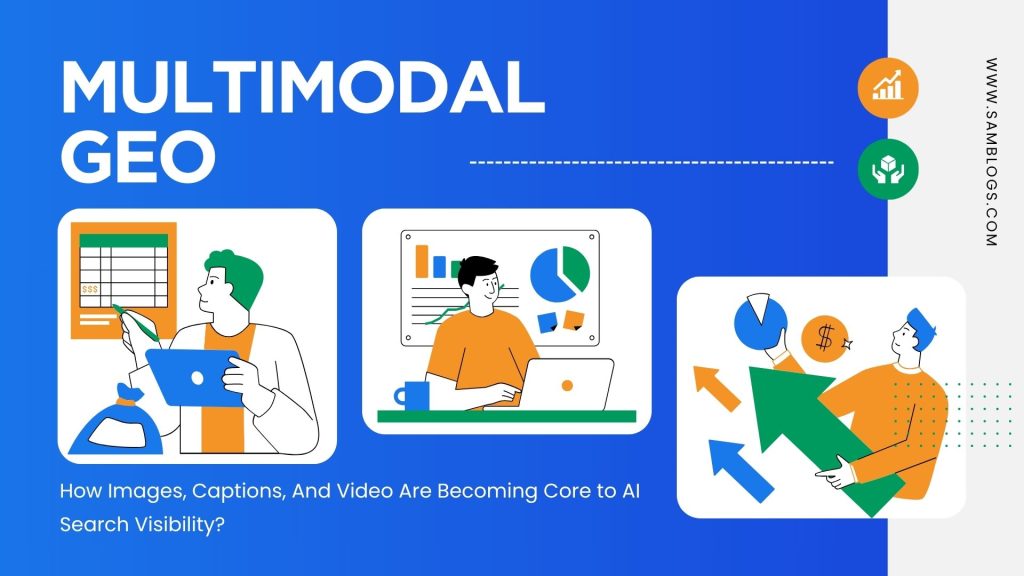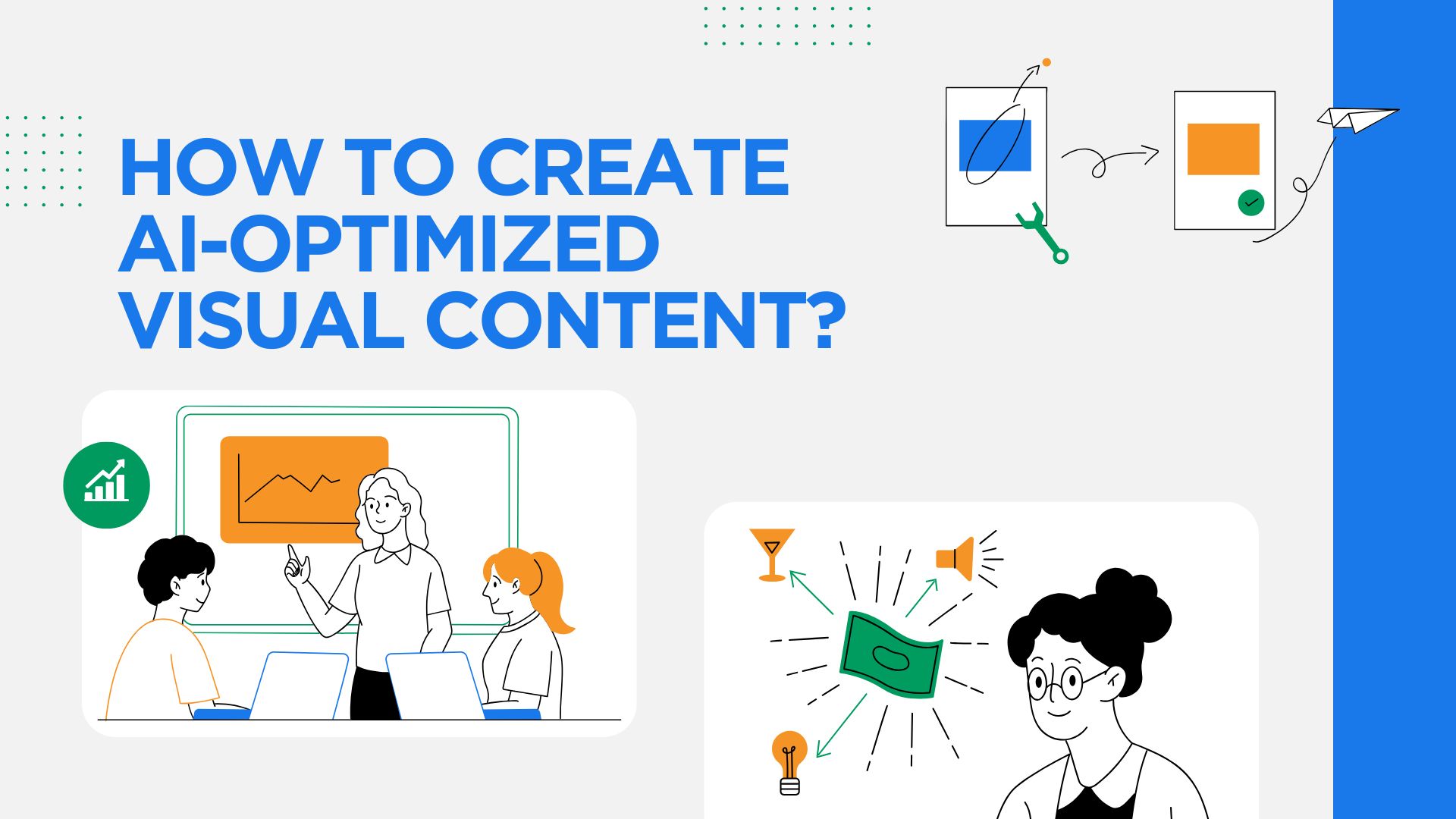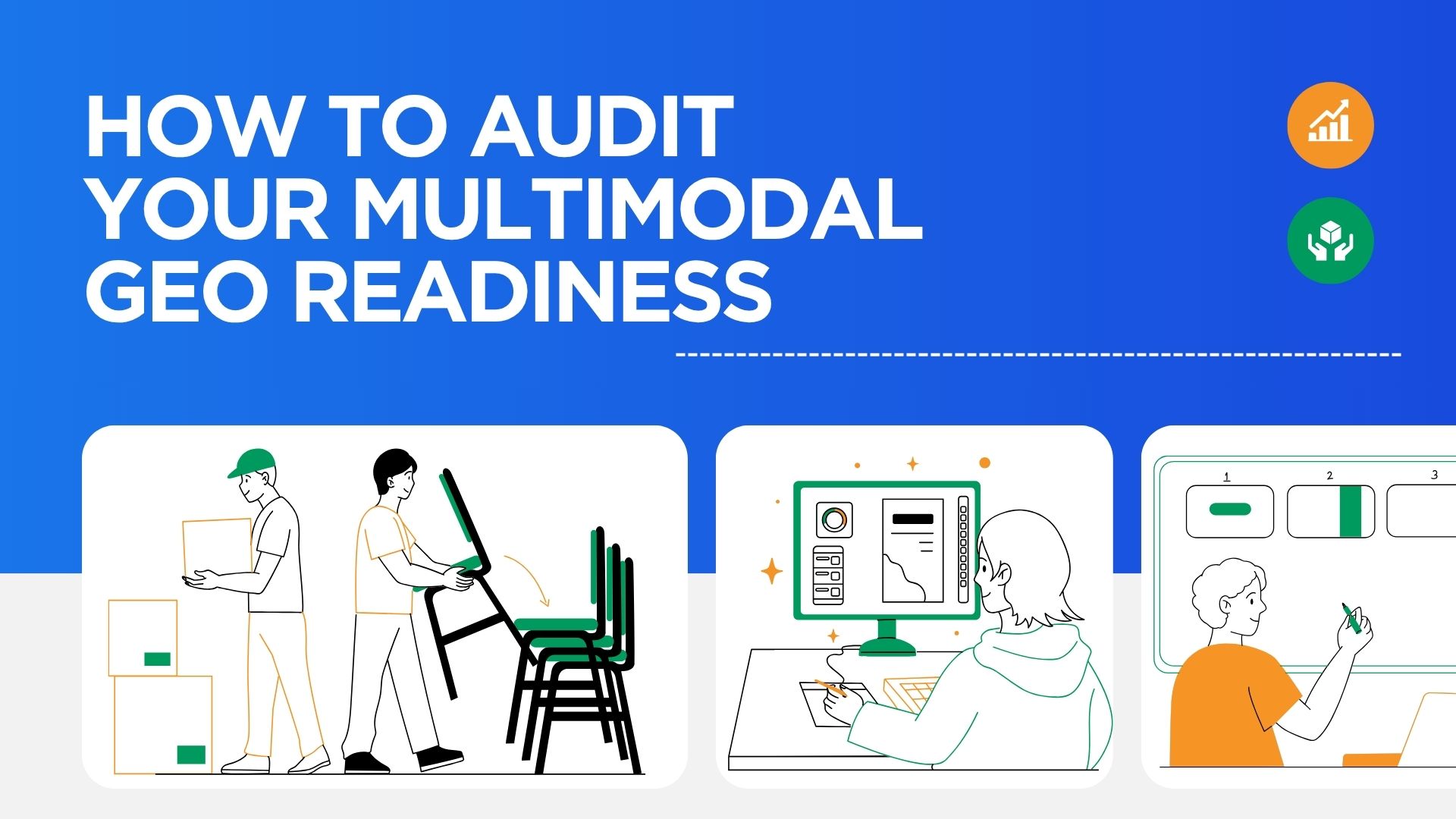Generative AIs are the new segment on the block, and they’re changing the game of SEO in the most radical way since mobile appeared on the scene. Until now, search engine optimization (SEO) has been chiefly about text: articles, where you put the keywords, your headings, and the anchor text of a link. The arrival of Gen-AI systems, the kind of models that are behind the new search engines, is basically rewriting the whole playbook. These new systems not only “read” the text; they “see,” “hear,” and “understand” the content in several formats at a time.
We are moving away from a web that is based on text only to a truly multimodal web. The fight for visibility can no longer be won by text alone in this new world. AI-powered search engines use images, video, audio, and the respective metadata as their primary sources to verify, organize, and present their results. This transition calls for a different optimization model: Multimodal GEO. In this article, we will detail the components of this new framework, exploring how to optimize visual assets and structured data to achieve core visibility in the age of AI search.
Contents
- 1 What Is Multimodal GEO (Generative Engine Optimization)?
- 2 The Role Of Multimodal RAG In AI Search
- 3 Why Visual Assets Are Increasingly Indexed by AI Models?
- 4 Caption Injection: Optimizing Captions & Alt-Text for AI Retrieval
- 5 Schema Markup for Multimodal Content
- 6 How to Create AI-Optimized Visual Content?
- 7 AI Models Favoring Multimodal Inputs: What This Means for SEOs
- 8 How To Audit Your Multimodal GEO Readiness
- 9 The Future of Multimodal Search
- 10 Conclusion
What Is Multimodal GEO (Generative Engine Optimization)?
Multimodal GEO refers to Generative Engine Optimization with a focus on multimodal resources. It is a marketing strategy that involves the optimization of digital sources, in particular, images, videos, and audio, together with the text (captions, transcripts, metadata), to be easily discovered, understood, and utilized by Generative AI models in creating search results.
Multimodal GEO is different from traditional SEO, which was designed to make a page of text rank higher; here, the goal is that your non-textual pieces become the evidence or the primary source for the AI-generated answer. In a multimodal search setting, an image is not just an embellishment; it is data.
The Role Of Multimodal RAG In AI Search
The core of present-day AI search is usually a method named Retrieval-Augmented Generation (RAG).
What Is Multimodal RAG And How Does It Function?
The way traditional RAG is done is by first using a query to retrieve the most relevant documents (text) from a vast index and then employing a Large Language Model (LLM) to generate the final answer based on the located pieces of information.
With the extension of Multimodal RAG, it is possible for the step of retrieval not only to resort to written data but also to images and audio files.
- Ingestion: The complete content, for example, the images, video frames, and audio transcripts, is changed into numerical forms, called embeddings.
- Indexing: The embeddings are being put in a vector database, thus creating a conceptual index that covers all modalities.
- Retrieval: Upon receiving a query (like “how to mend a dripping faucet” from a user), the AI turns the query into an embedding that is employed in the search of the vector database. The system pulls out the text and visual/audio resources that have the highest semantic similarity.
- Generation: The LLM refers to this amalgam of text, images, and video snippets as the source of its evidence, with which it generates a full-fledged, reliable, and in many cases, visually supported response.
How AI Engines Retrieve Visual Assets As Evidence?
The principle of semantic similarity is what AI models use when they try to obtain visual assets as evidence.
- They do not search for the exact keyword in the image file name.
- What they do is take the visual embedding of the image and mix it with its context (captions, alt-text, paragraph text) to get the connection to the user’s needs.
For instance, a query like “life cycle of a monarch butterfly” may find the following:
- The text explains the phenomenon.
- An image showing the stages of the cycle, whose caption details the labeled parts. The AI gets both the picture and the explanatory text.
How Do Embedding Models Match Visual Content With Search Intent?
Embedding models (like CLIP) are trained to locate images and text that describe these images in the same conceptual space in the vector database. So, basically, this means:
- The embedding for the image of a “golden retriever puppy”
- The embedding for the text “fluffy young dog with golden fur”
This combined representation is what allows the AI to find a text query (“What does a young golden dog look like?”) that best fits an image asset.
Why Visual Assets Are Increasingly Indexed by AI Models?
Visual and audio data are not “less important” anymore; they are becoming the primary sources of verifiable information that generative models use.
Images As Authoritative “Proof” For AI Responses
Generative AI models aim to be factual. The response is thereby a lot stronger if clear visual evidence supports it in the case of a question like “What is the structure of DNA?”. An image acts as definite proof or a visual demonstration, which makes the AI-generated answer more reliable and valuable. AI prefers those assets that clearly show or explain the answer.
Videos Offering Structured, Factual Density
A short instructional video of 5 minutes is made up of hundreds of video frames, along with the audio transcript that is rich in semantic data.
- Timestamps and Key Moments Markup: Video schema enables the AI to locate the exact time when a specific fact is mentioned or shown. For instance, a video on bread-making may have a key moment for “kneading the dough.” The AI thus can retrieve this instance as a high-density, fact-checked asset.
- Sequential Logic: Most of the time, videos present information in a logical, step-by-step sequence (e.g., tutorials, processes), which the AI finds easier to break down and present as a structured, generated answer than a lengthy text.
Audio Transcripts Contributing To Semantic Search
In the case of both videos and standalone podcasts, the audio transcript is a vibrant source of text that is open to search. This text is usually more natural, conversational, and often talks about a broader range of related topics than a highly structured blog post. Transcripts deepen the semantic layer of the content, which enables the AI to link user queries with the exact, relevant spoken words.
Image-Caption Pairs Boosting Retrieval Accuracy
The most valuable thing for an AI is not only a photo, but a photo with a clear, descriptive, and keyword-rich caption.
- The photo offers the visual data.
- The caption/alt-text gives the AI the most direct textual label for understanding what the photo is.
This duo is essential for the precise retrieval of multimodal RAG systems. A caption like “Diagram illustrating the transformation of solar energy into chemical energy during photosynthesis” tells the AI the exact content of the unlabeled image, by far increasing the chances of retrieval.
Caption Injection: Optimizing Captions & Alt-Text for AI Retrieval
Caption Injection is the fundamental multimodal asset optimization method. It denotes the careful positioning of consistent, keyword- and entity-rich, descriptive text right next to or within a visual asset to direct the AI’s understanding and extraction method.
What Does Caption Injection Mean In AI Search?
This is the work of making sure that each visual and video asset has accompanying text that clearly, briefly, and comprehensively describes its content, purpose, and connection to the rest of the content. This text is Metadata of the content into which it is inserted, thus making it highly visible and usable by the AI.
Writing AI-Friendly Captions
Captions that help AI should be:
- Descriptive: Clearly indicate what is in the photo or video frame. (e.g., NOT: “Our team at work.” BETTER: “Engineers collaborating on a 3D model of a high-efficiency jet engine.”)
- Keywords Rich (Contextual): Relevant keywords, context-specific, and named entities should be introduced naturally.
- Full Sentences: AI models work better with grammatically complete sentences as they give a deeper understanding of the context.
- Fact-Based: Use the visuals’ captions to communicate the exact facts that the visuals are showing.
Optimizing Alt-Text For Generative Engines
Captions are visible to everyone, but alt text is mainly intended for search engines and accessibility tools. Alt-text for AI should be:
- Function-Focused: Describe the function of the picture, not just the picture.
- Concise: Always try to be short, but enough to be understood by others, mostly less than 125 characters.
- Unique: The same words should not be used for the caption and alt-text; they are different things.
Avoiding Over-Optimization And Keyword Stuffing
Like regular SEO, AI models also penalize accounts that perform spammy activities. There are some things that you should not do, such as:
- Keyword Stuffing: This refers to filling the alt-text or captions with a long, repetitive list of keywords without giving much thought to the text.
- Irrelevant Keywords: Employing frequently searched keywords that do not correspond to the visual content.
Schema Markup for Multimodal Content
Structured data (Schema Markup) is the “language” that makes content explicitly understandable to search engines.
For multimodal GEO, a schema is a must-have as it converts raw resources into structured, factual data points.
Video Schema: Transcripts, Timestamps, Key Moments Markup
The VideoObject schema is the main factor that determines the visibility of a video. The main properties for AI retrieval are:
- Transcript: The full text of the video’s spoken content, and the most important one for semantic search.
- Duration: Helps the AI determine how long the video is.
- embedUrl: The location of the video.
- Clip or SeekToAction: Markup that indicates the key moments with the start and end time and a label. This way, the AI can show these particular, brief extracts as the answer to the user’s query.
Image Schema: Licensing, Creator Info, Subject Metadata
Even though the basic image SEO requires alt-text, advanced Multimodal GEO employs the ImageObject schema to give:
- Creator: Indicating the source of the image and its reliability.
- License: Determining the usage rights that AI models are gradually implementing.
- Caption: Supporting the visible caption.
- subjectOf: Associating the image with a particular entity (e.g., a Wikipedia page for a specific landmark).
Audio Schema: Transcripts, Speaker Labels, Topics
The schemata AudioObject or PodcastEpisode are used for indexing the content of podcasts or standalone audio by the AI:
- Transcript: The most important one for search.
- Speakable: Indicating the parts of the audio that contain valuable information and can be used in a generated spoken answer.
- temporalFragment: Similar to the key moments concept in videos, it is used for marking specific, topic-oriented sections in the audio.
Multimodal Structured Data For AI-Rich Understanding
With schema, you can link different types of content. For instance, the mainEntityOfPage property can be used to link a photo, a video, and a written article to one single, broad topic. This comprehensive perspective allows the AI to consider the whole content cluster as a reliable source.
How Schema Improves Retrieval In Multimodal RAG Systems
Schema gives the AI the real, verified data it needs. When an AI is on the lookout for assets, it has to be able to judge their usefulness and truthfulness. Schema acts as a well-organized, machine-readable layer of confirmation:
- Precision: It provides the AI with the exact information of what a video segment deals with (e.g., “3:15 to 3:45 talks about the current state of blockchain adoption”).
- Authority: It confirms the creator and the asset’s context.
This detailed accuracy makes assets with schema marking very attractive to the RAG process.
How to Create AI-Optimized Visual Content?
Simply modifying the existing pieces of work is not enough; the works of art have to be AI-friendly right from their inception.
Designing Images That Communicate Explicit Concepts
AI is most effective when learning from visuals that are not only clear but also simple.
- Favour Labeled Components & Infographics: Images that not only label components, but also illustrate processes by means of flowcharts, or comparative use of side-by-side images, are the most helpful ones for AI.
- Get rid of Ambiguity: Artistic, vague, and heavily stylized photos can lead to confusion in AI’s vision models. So, always present clear and factual representations.
Creating “Caption-First” Visuals For AI-Readability
Before the production of a graphic, point out: “What single sentence would best describe this visual to the AI?”
- The graphic should be able to depict that one sentence fully.
- The core message from the graphic should be so clear that even if AI is just able to see a low-resolution thumbnail or a short description, it would get the message.
Using Text-On-Image Sparingly To Reinforce Meaning
AI is capable of reading the text in the image; still, it is not always accurate. So, therefore, if you are going to use text on an image (like titles, labels) to help a concept, it should also be explained in full in the neighboring text (caption/alt-text). Essential, unique information should never be put in an image without being accompanied by the rest of the text.
Producing Short Explanatory Videos For Vertical AI Search
AI models usually prefer short and focused videos to long ones.
- Produce Topic-Specific Clips: Instead of one 30-minute master class, create 10 separate 3-minute videos, each tailored to answer a specific question (e.g., “How to change a car’s oil filter” vs. “Full car maintenance”).
- Prepare For Transcription: Make speakers speak clearly, use technical terms accurately, and organize their points logically. This will not only make the transcript cleaner and more useful for AI but also for other users.
AI Models Favoring Multimodal Inputs: What This Means for SEOs
The transition to multimodal inputs has been mainly due to AI models getting more advanced in reasoning.
- Better Grounding: The AI can base its answer on two different types of data by getting text and a relevant image or video clip. This results in higher confidence and fewer hallucination cases; thus, the AI inherently prefers multimodal sources.
- Enhanced Presentation: AI search output is becoming more visual and interactive. A generated response, along with a sourced, high-quality visual, stands a better chance of being the main output (e.g., in a featured snippet or AI-generated summary) than one without the visual.
- The Power of Seeing: To be factual, especially when talking about medicine, engineering, or nature, a visual tool provides an extra, undeniable level of authority that even the best-written text cannot offer. Thus, SEOs should transition from being solely keyword strategists to multimodal content architects.
How To Audit Your Multimodal GEO Readiness
A Multimodal GEO audit is a detailed examination that helps you find the missing links in your visual and audio content strategy.
Visual Asset Inventory Checking
- Objective: Figure out the number of images on main pages that are not correctly optimized.
- Inspection: Locate every image. Does it have a unique filename, descriptive alt-text, and a user-facing caption?
Caption + Metadata Completeness Metric
- Objective: Measure the descriptive quality of the text.
- Inspection: Rate the captions and alt-text using a rubric: 1) Are they descriptive? 2) Do they contain relevant entities? 3) Are they contextually accurate?
Video Transcript Coverage Audit
- Objective: Make all video content accessible through a search engine.
- Inspection: Is a complete, accurate, and time-synced transcript available for every video? Is the footage enriched with the VideoObject schema and Key Moments? Videos without transcripts are virtually invisible to AI.
Image SEO vs. Multimodal GEO Gap Analysis
There exists a significant difference between conventional Image SEO and Multimodal GEO:
- Conventional Image SEO is centered around a single focus keyword in the alt text and a primary objective of ranking in Google images.
- Multimodal GEO emphasizes the use of function, description, and key facts of the image in the alt text, employing detailed and keyword-rich sentences in the caption for AI infiltration, as well as the inclusion of video/audio assets with accompanying structured data.
- Multimodal GEO’s final objective is not simply to rank an image but to have the asset retrieved as evidence to support the AI-generated answer.
The Future of Multimodal Search
The AI reasoning that can cross-reference information from all modalities simultaneously is where the trend is heading.
- Deeper Visual Search: The AI of tomorrow will be capable of making such inferences purely from the visuals, as, for instance, “What is the model number of the tool in the user’s hand?” from a video, even if the number does not exist in the transcript.
- Interactive Answers: Through optimization of content, AI-generated answers will progressively involve interactive diagrams, 3D models, or annotated images with references pulled from optimized content.
- Personalized Modality: The AI will figure out whether a user prefers a video explanation or a text-based diagram and will therefore give that content type priority in the generated answer, thus making Multimodal GEO an essential factor in personalization.
Conclusion
As the search engine transforms into a Generative AI platform, the rules of visibility are being altered along with it. Multimodal GEO is not an option; it is the new standard of digital visibility.
What makes your content seen, heard, and understood by the next generation of AI search is the integration of images, videos, captions, and structured data.
SEOs and content creators, by emphasizing clarity, semantic richness, and structure across all content formats, can not only secure their authority but also ensure their resources are the most attractive source materials for the AI-driven web. The future of search is visual, and those who make the Multimodal GEO investments today will be the leaders tomorrow.






